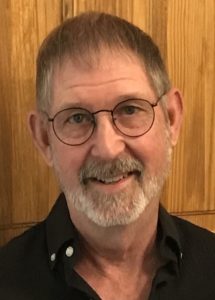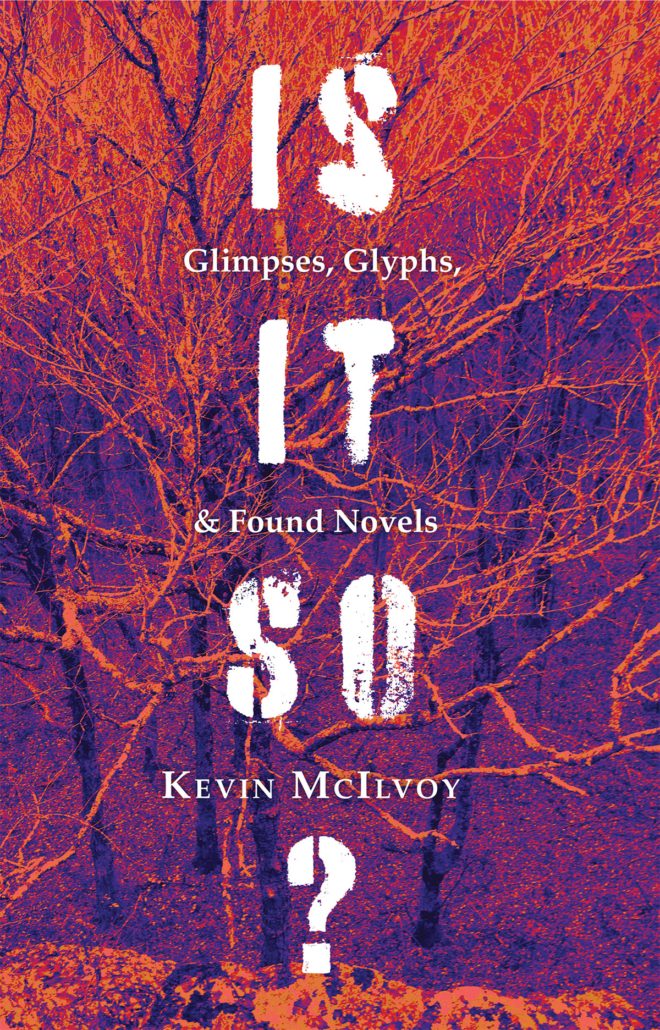Is It So? Glimpses, Glyphs, and Found Novels by Kevin McIlvoy
Beloved faculty member Kevin McIlvoy’s last book, Is It So? Glimpses, Glyphs, and Found Novels, will be released on November 7th. Work from the novel will be featured at a free virtual reading. Visit www.wtawpress.org to learn more.
Below, read the introduction to the book, written by Mc’s wife, Christine Hale (Fiction ’96).
From the Writer’s Wife: An Introduction to Is It So?
In the summer of 2022, Mc handed me the manuscript of Is It So?: Glimpses, Glyphs & Found Novels for comment. I read it with an accumulating sense of wonder and told him, when I’d finished, “Mc, you have written a quite marvelous last book.” His response, typical of him—his habit of humility and his confidence in the power of truths left unspoken—was silence. A warm silence. Did I feel in that moment the cool shadow of foreboding of his death, less than four months away? I can’t say that I did. That shadow had always been with us.
Death figures prominently in Is It So? but it was not for that reason I perceived culmination in the pages of this book. These pieces offer fulsome evidence of Mc’s decades-long preoccupation with somatic prehension; with storytelling via indirection, transformation rather than transaction, and enacting rather imparting; and with the diction and rhythms of vernacular speech, especially what is withheld from or hidden inside speech. The stories in Is It So? demonstrate his deepening commitment to the irreal, the carnivalesque, to ghost stories, fairy tales, the short short form, and to prose poems or—in his words—writing that lands in “the gulley” between prose and poem.
Is It So?, his final book of fiction, is also so much who Mc McIlvoy, the artist and the man, had come to be in the last decade of his life. A skilled hybridist playfully mashing up literary genres with visual art and music. An evermore gentle spirit toward children and the inner child. A ruthlessly clear-eyed comic on ageing bodies and ageist erasure. An activist increasingly enraged by capitalism’s destruction of beauty, human dignity, and democracy. And, within all that energy, a calm-abiding Buddhist dedicated to a practice of seeing, saying, and letting go.
The first six pieces in Is It So? can be read as Mc’s instruction—subtle and indirect as ever—on how to read his work. In “A Difficulty” the narrator says, “I get goldfish, really get them. I can be them, draw them—still—and moving.” The narrator in “If a small ocean” says that in his art he “render[s] the mass and the volume under the masks the body wears,” and that he has “studied the techniques for drawing transparencies because clear surfaces found me in every subject appearing before me.”
Mc is telling us that his lifelong compulsion to carefully listen to and observe people, their speech, and their circumstances—especially those who are odd, overlooked, or actively dismissed—has led him to perceive everywhere story, suggested but never completely, coherently exposed, and always expressed through the consciousness unique and subjective to that being and that circumstance. Mc’s friend Sebastian Matthews has written in tribute to Mc that his stories arise from so deeply within his characters’ heads and hearts that “what comes off as whimsical or slightly mad or wildly surreal or just a little strange is actually true to life…the real-time lunacy of being human, of one human trying to connect with another.”
These attempts to connect—in service of and despite the real-time lunacy of human heads and hearts—inform every piece in Is It So? In “Cake all day,” a paralyzed, cognitively impaired stroke survivor and her brother-in-law pass their time during visits “attentive to each other’s self-talk,” which centers on cake, object of desire and wonky, deflective metaphor for all the suffering neither can bear to address directly. A thought experiment in co-conscious connection: “They did not ask each other to clarify what they overheard…They did not interleave…They took turns witnessing, alert in the listening.”
The “found novels” in Is It So? wed Mc-the-novelist’s paradoxical fascination with the short short form to this book’s focus on rendering transparencies. Set in Desordenada, North Carolina, a made-up town name suggesting disorganization, the novels Mc “found” there extend the concept of the found poem into a novel’s worth of suggested story. The few words comprising each novel are the transparency that veils and evokes prehension of the withheld narrative. The terms “glimpses” and “glyphs” in the book’s subtitle underline its fealty to radical compression and to rendering the mass and volume of what is only ever implied.
In “Passersby,” Mc-the-hybridist joins his omnivorous appreciation of music with his late life venture into dance as another means of inhabiting music with his established habit of storytelling through the consciousnesses of the sidelined. Here, the bit players with walk-by roles in Gene Kelly’s virtuoso dance performance of “Singing in the Rain” in the 1952 film of the same name take center stage, to assert humbly yet passionately that their bit parts in a seminal event matter precisely because of the strenuous effort of their artistry to get it right.
This book may be the most personal of Mc’s prose works. In the autographical bits—disguised, as is all autobiography in all his works by veiling, distortion, and transposition—he is, as I see it, putting his heart in order. There is reckoning— the jettisoning of romantic notions about self and others, and acknowledgment that too often our self-delusions mean we fail to see what’s beneath a clear surface. But there is equally present the hard-won wisdom of an elder taking the long view on life’s trials and joys, and the inevitability of death. The forest ranger at the center of “In the Gila” chides the narrator, “You don’t see what you should.”
Although this book tunnels deep into the dark and desperate recesses of long-life experience, it ultimately leads to light: in the final piece, a pilgrim in the DMV slowly ascends dusty stairwells to the Office of the Clerk of Happiness. I read Is It So? as a writer’s testament to walking the path with awareness, blessing equally what is and what is no more, moving incrementally further into joy by letting go of attachment, delusion, aversion—and life.
Christine Hale
June 2023




